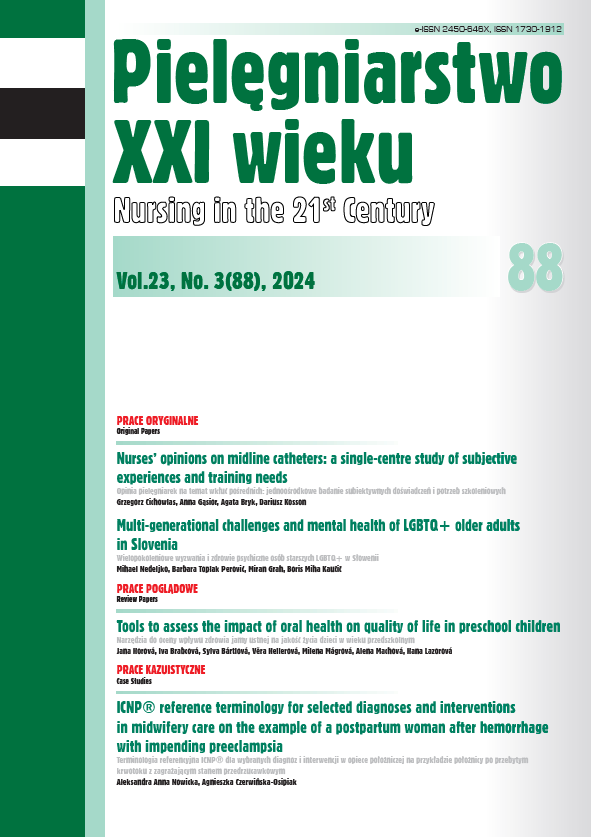Exploring the perception of nursing students facing burnout in clinical settings during COVID pandemic
DOI:
https://doi.org/10.2478/pielxxiw-2024-0036Keywords:
burnout, COVID-19, pandemic, nursing students, clinical experienceAbstract
EXPLORING THE PERCEPTION OF NURSING STUDENTS FACING BURNOUT IN CLINICAL SETTINGS DURING COVID PANDEMIC
Aim. The purpose of this study was to learn about the experience of the group of students who are at high risk for experiencing burnout and nursing shortage. This study seeks to reveal students’ perception of nursing burnout and nursing shortage observed during a clinical course.
Material and methods. This study was conducted with a qualitative method using conventional content analysis approach. Data were collected by conducting in-depth semi-structured interviews.
Results. Thematic analysis of the interview transcripts identified four core themes, with corresponding sub-themes: Sources of burnout, Uncertainty, Coping Strategies, Varying faculty support during clinical rotation. This study proves that nursing students experienced similar feelings of burnout and emotional strain during their clinical rotation during COVID. Evidence highlights the impact of psychological stress on nursing students in pandemic circumstances and additionally the stress of completing all required competencies to complete their degree.
Conclusions. The findings of this study include sources of burnout such as working conditions, workload, dealing with suffering, death, and dying, and uncertainty in the present and future such as the evolving and changing understanding of COVID. Coping mechanisms involve staying positive and talking to family and friends. Finally, the varied opinions of the students regarding emotions and feelings of support from faculty.
References
1. Buchan J, Catton H, Shaffer FA. Sustain and retain in 2022 and beyond - international council of nurses. International Council of Nurses; 2022.
2. Dall'Ora C, Ball J, Reinius M, Griffiths P. Burnout in nursing: a theoretical review. Human Resources for Health. 2020;18(1):1-41. https://doi.org/10.1186/s12960-020-00469-9.
3. Burn-out an "occupational phenomenon": International classification of diseases. (2019, May 28). World Health Organization (WHO). https://www.who.int/news/item/28-05-2019-burn-out-an-occupational-phenomenon-international-classification-of-diseases.
4. Hetzel-Riggin MD, Swords BA, Tuang HL, et al. Work engagement and resiliency impact the relationship between nursing stress and burnout. Psychological reports. 2020;123(5):1835-1853. https://doi.org/10.1177/0033294119876076.
5. Arian M, Jamshidbeigi A, Kamali A, et al. The prevalence of burnout syndrome in nursing students: A systematic review and meta-analysis. Teaching and Learning Nursing. 2023;18(4):512-520.
6. Kong LN, Yao Y, Chen SZ, et al. Prevalence and associated factors of burnout among nursing students: A systematic review and meta-analysis. Nurse. Educ. Today. 2023;121:105706. doi: 10.1016/j.nedt.2022.105706.
7. Moser A, Korstjens I. Series: Practical guidance to qualitative research. Part 3: Sampling, data collection and analysis. European journal of general practice. 2018;24(1):9-18. https://doi.org/10.1080/13814788.2017.1375091.
8. Creswell JW. A concise introduction to mixed methods research. SAGE publications, 2024.
9. Sandelowski M. Whatever happened to qualitative description?. Research in nursing & health. 2000;23(4):334-340.
10. Colaizzi P. Psychological research as a phenomenologist views it. [in:] Valle RS, King M. Existential Phenomenological alternatives for psychology. Open University Press: New York, 1978.
11. Sanders C. Application of Colaizzi’s method: Interpretation of an auditable decision trail by a novice researcher. Contemporary nurse. 2003;14(3):292-302.
12. Lincoln Y. Ethical Practices in Qualitative Research. Teoksessa Donna Mertens & Pauline Ginsberg (toim.) The Handbook of Social Research Ethics, 2009.
13. Gray JR, Grove SK, Sutherland S. Burns and grove's the practice of nursing research-Ebook: Appraisal, synthesis, and generation of evidence. Elsevier Health Sciences, 2016.
14. Patton MQ. Enhancing the quality and credibility of qualitative analysis. Health services research. 1999;34(5):1189.
15. Khamisa N, Peltzer K, Oldenburg B. Burnout in relation to specific contributing factors and health outcomes among nurses: a systematic review. Int. J. Environ. Res. Public Health. 2013;10(6):2214-2240. doi: 10.3390/ijerph10062214.
16. Shah MK, Gandrakota N, Cimiotti JP, et al. Prevalence of and Factors Associated With Nurse Burnout in the US. JAMA network open. 2021;4(2):e2036469. https://doi.org/10.1001/jamanetworkopen.2020.36469.
17. Cañadas-De la Fuente GA, Gómez-Urquiza JL, Ortega-Campos EM, et al. Patient-nurse ratio is related to nurses' intention to leave their job through mediating factors of burnout and job dissatisfaction. International Journal of Environmental Research and Public Health. 2019;16(23):4801. https://doi.org/10.3390/ijerph16234801.
18. Gutsan E, Patton J, Willis WK, et al. Burnout syndrome and nurse to-patient ratio in the workplace, 2018.
19. Vuong L. Staffing ratios and burnout. AJN The American Journal of Nursing. 2020; 120(5):13
20. Lai J, Ma S, Wang Y, et al. Factors associated with mental health outcomes among health care workers exposed to coronavirus disease 2019. JAMA network open. 2020;3(3):e203976-e203976.
21. Hu D, Kong Y, Li W, et al. Frontline nurses’ burnout, anxiety, depression, and fear statuses and their associated factors during the COVID-19 outbreak in Wuhan, China: A large-scale cross sectional study. E Clinical Medicine. 2020;24:100424.
22. Mufarrih SH, Qureshi NQ, Hashmi SA, et al. Is the fire even bigger? Burnout in 800 medical and nursing students in a low middle income country. PLoS One. 2024;19(8):e0307309. doi: 10.1371/journal.pone.0307309.
23. Olmos-Bravo ZM, Sánchez-Ortí JV, Grevet EH, et al. Prevalence and associated factors of burnout among health sciences students in Spain - a systematic review. Trends Psychiatry Psychother. 2024. doi: 10.47626/2237-6089-2024-0805.
24. Lindsay J, Cropley S, Benton A, et al. The COVID-19 Lived experience through the eyes of nursing and social work students. Creat. Nurs. 2024;30(2):145-153. doi: 10.1177/10784535241247093.
Downloads
Published
Issue
Section
License
Copyright (c) 2024 Authors

This work is licensed under a Creative Commons Attribution-NonCommercial-NoDerivatives 4.0 International License.




